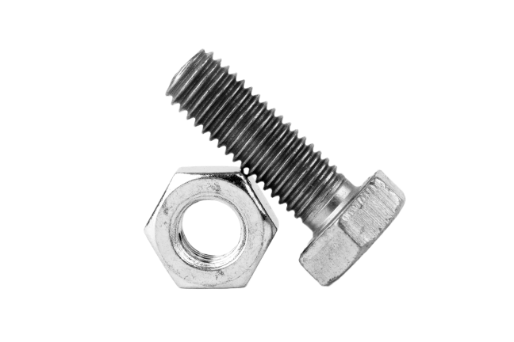
Choosing the right hex nut is crucial in construction and DIY projects. It impacts the integrity, functionality, and safety of assemblies and structures. Understanding dimensions, sizes, and types of hex nuts is vital. The correct size and material ensure a perfect fit and durability in different environments. This introduction highlights the importance of size and material considerations in hex nut selection.
The Comprehensive Guide to Hex Nut Sizes
Hex nuts come in a wide variety of sizes that are designed to accommodate different bolt sizes and strength requirements.
Key Dimensions of Hex Nuts
Hex nuts are categorized by nominal thread diameter, width across flats, and thickness. These dimensions ensure a secure fit with corresponding bolts or screws which is essential for the structural integrity of the joint.
Importance of Accurate Sizing
A hex nut size chart is an invaluable tool in this process, that aids in the selection of the right size for your specific needs. For instance, the width across flats is crucial for determining the correct wrench size for installation, and the thickness gives an insight into the nut's load-bearing capacity.
Navigating Hex Nut Sizes and Utilizing Size Charts
Understanding Size Variations
Hex nuts come in a diverse range of sizes, each tailored to meet different requirements and standards. To select the right hex nut for your project, it’s important to understand the key metrics that categorize these sizes:
Nominal Thread Diameter
The Nominal Thread Diameter refers to the screw or bolt diameter that the nut is designed to fit. It's measured in millimeters or inches, depending on the standard. The diameter determines nut compatibility with a specific bolt or screw.
Width Across Flats
The Width Across Flats is the distance between two opposite sides of the hex nut. This dimension is crucial as it determines the size of the wrench or socket used to tighten or loosen the nut.
Thickness
The thickness of a hex nut is the measurement from one flat face to the opposite flat face. This dimension is particularly crucial as it directly influences the load-bearing capacity of the nut.
Using Hex Nut Size Charts
Size charts are crucial tools in the selection process, and they are an easy way to compare various hex nut sizes and their dimensions.
Metric vs. Standard Sizes
Hex nuts are available in both metric and standard (Imperial) measurements:
- Metric Sizes: Common sizes include M6, M8, and M10.
- Standard (Imperial) Sizes: Frequently used sizes are 1/4", 3/8", and 1/2".
The choice between metric and standard sizes should be based on your project's specific needs and prevailing regional or industry standards.
Sample Hex Nut Size Chart
Choosing the right size and material for a hex nut is crucial to ensure a proper fit with bolts or screws. It also affects usability and durability in different environments. By making the correct choices, you can ensure stability and longevity in your construction or DIY project. Remember to align the hex nut with the project requirements and corresponding fasteners.
Material Considerations for Hex Nut Selection
The material of a hex nut significantly influences its suitability for various applications:
- Materials like stainless steel, known for their corrosion resistance, are ideal for outdoor or marine environments.
- Carbon steel, valued for its strength, is typically used in high-load applications.
- Brass and aluminum, each with unique properties like corrosion resistance and lightweight, cater to specific needs like electrical conductivity or aerospace applications.
The choice of material should align with the environmental conditions and the mechanical demands of the project.
Types of Hex Nuts
Understanding the different types of hex nuts is crucial for making informed decisions about their use in various applications. Each type has unique characteristics and is designed for specific purposes:
Finished Hex Nuts
These are the standard hex nuts used in most applications. They offer a good balance of strength and versatility, and are suitable for general use in construction and machinery.
Heavy Hex Nuts
Larger and thicker than standard hex nuts, heavy hex nuts are designed for applications that require a stronger, more robust connection. They are often used in construction projects, particularly where structural strength is a priority.
Nylon Insert Lock Nuts
These nuts have a nylon insert that grips the bolt threads to provide a locking feature. This prevents the nut from loosening under vibration or movement, which makes them ideal for applications where stability is crucial.
Jam Nuts
Thinner than standard hex nuts, jam nuts are typically used as a type of locknut, where they are "jammed" up against a standard nut to lock the two in place. They are useful in situations where space is limited or where a low-profile nut is needed.
Flange Nuts
Equipped with a wide flange at one end, flange nuts act as an integrated, non-spinning washer. This distributes the pressure over a larger area, which is ideal for applications where the surface material is softer, like wood or plastic.
Coupling Nuts
Coupling nuts are long, cylindrical nuts used to connect two pieces of threaded rod or other male threaded fasteners, which makes them suitable for applications that require a strong, extended length connection.
Each type of hex nut serves a distinct purpose and choosing the right one depends on the specific requirements of your project. Consider factors such as the application environment, the type of load the connection will bear, and whether the assembly will be subject to vibration or movement.
Essential Tips for Selecting the Right Hex Nut
Selecting the right hex nut for your project involves more than just matching sizes. You need to consider the material of the nut, which should be compatible with the bolt material to prevent corrosion. The environment in which the nut will be used also plays a role – outdoor applications may require corrosion-resistant materials like stainless steel.
Matching Hex Nut and Bolt Materials
Ensuring compatibility between the hex nut and bolt materials is a critical factor in any assembly. When these two components are made from different metals, a phenomenon known as galvanic corrosion can occur, which may cause the connection to weaken over time. This means, for instance, if you're using a stainless steel bolt, it's typically best to match it with a stainless steel hex nut.
Likewise, a carbon steel bolt pairs well with a carbon steel hex nut. Prioritizing material compatibility helps maintain the integrity of the connection and increases the lifespan of your project.
Avoiding Common Measurement Errors: Best Practices
Accurate measurement is vital in selecting the right hex nut. Mistakes in measurement can lead to loose connections that can compromise the integrity of the entire structure. Use precise tools like calipers for measurement and always double-check your readings against the size chart.
Explore a Wide Range of High-Performance Hex Nuts at Fastener Systems
At Fastener Systems Inc. (FSI), we offer a wide range of high-quality hex nuts for various applications. Each hex nut is carefully engineered to ensure a perfect fit, superior strength, and reliable performance. We also carry a full line of screws, bolts and other fasteners, as well as caulks, tape and tools.
Contact us today for more information!


